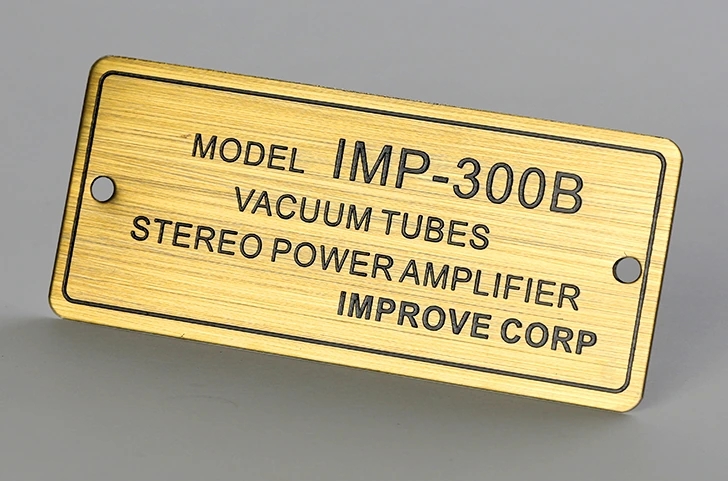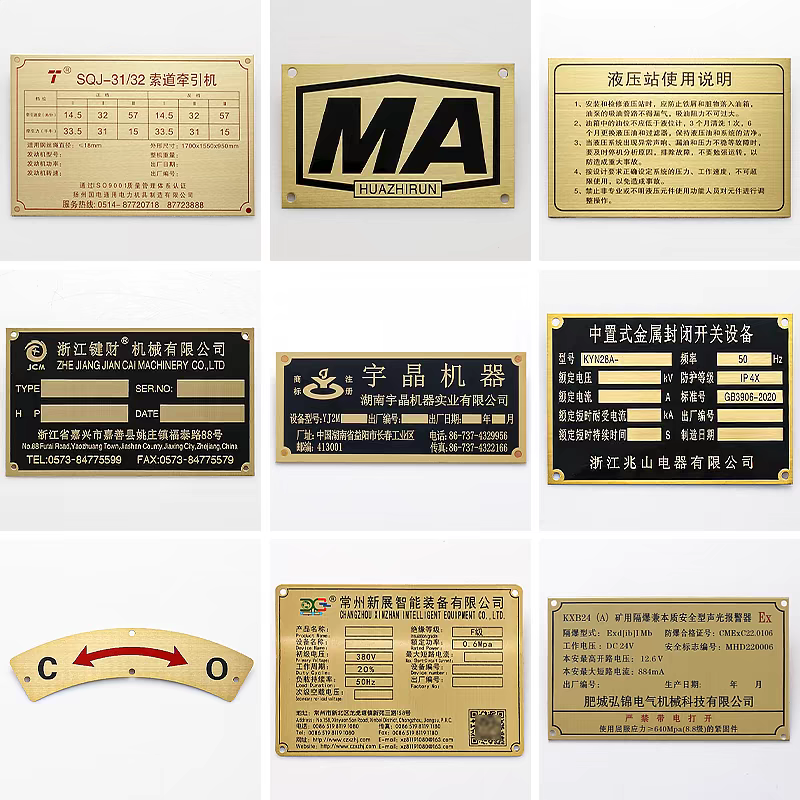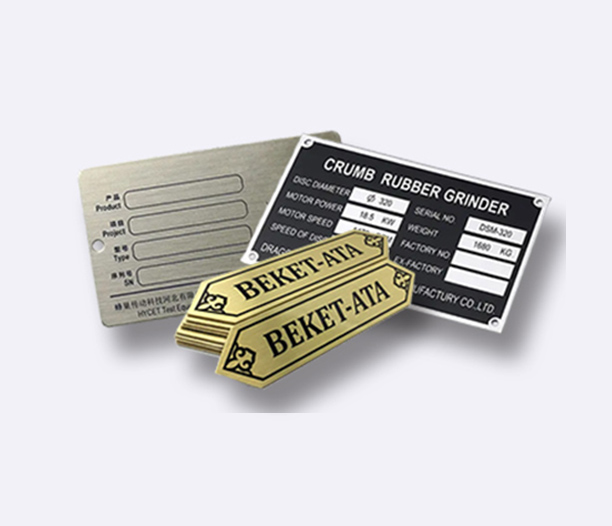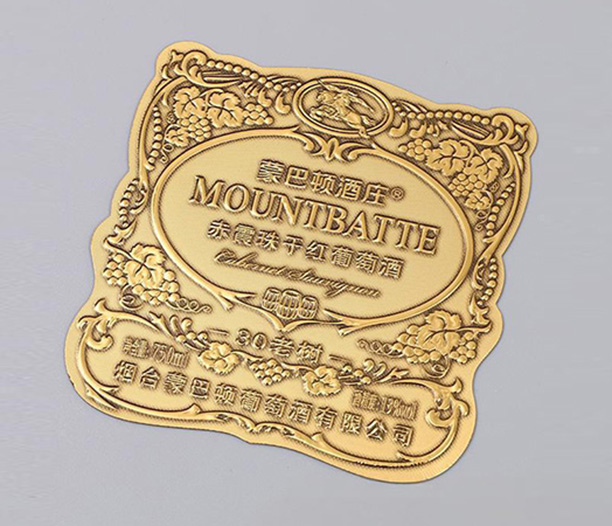When asset identification demands unwavering durability, extreme resilience, and absolute permanence, engraved stainless steel tags stand as the undisputed champion. Far surpassing the limitations of labels, stickers, or even other metal tags, these robust identifiers offer unparalleled performance in the harshest environments and the most critical applications. This in-depth guide explores why engraved stainless steel tags are the go-to choice for industries where reliability is non-negotiable, covering their core benefits, applications, and key considerations.

1. Unmatched Durability & Resistance: Built to Last Decades
The fundamental advantage of engraved stainless steel tags lies in their extraordinary resilience. Crafted from alloys like 304 or 316 stainless steel, these tags possess inherent properties that make them virtually impervious to common destructive forces:
Extreme Corrosion Resistance: Stainless steel's chromium content forms a passive oxide layer, protecting it from rust, oxidation, and degradation caused by water, humidity, salt spray (crucial for marine environments), and many chemicals. Grade 316 offers superior resistance to chlorides and acids.
High-Temperature Tolerance: Engraved stainless steel tags withstand intense heat (often exceeding 1000°F / 538°C continuous) and thermal cycling without melting, warping, or losing legibility. This is vital for engines, boilers, furnaces, and processing equipment.
Abrasion & Impact Resistance: The inherent hardness of stainless steel protects the engraved information from being worn away by friction, scraping, vibration, or physical impacts that would destroy plastic labels or softer metals.
UV Stability: Unlike printed labels that fade rapidly in sunlight, the engraving on stainless steel is integral to the metal and completely immune to UV degradation, ensuring permanent readability outdoors.
Chemical & Solvent Resistance: Resistant to a wide range of industrial cleaners, oils, greases, fuels, solvents, and mild acids/alkalis, ensuring the tag surface and marking remain intact.
This combination of properties ensures that engraved stainless steel tags provide a permanent, tamper-resistant, and highly legible identification solution for the entire lifespan of the asset, often decades.
2. Thriving in the Harshest Environments: Where Other Tags Fail
Engraved stainless steel tags excel precisely where other identification methods falter. Their robustness makes them indispensable across numerous demanding sectors:
Industrial Manufacturing: Withstanding cutting fluids, coolants, oils, grease, high-pressure washdowns, and physical impacts on machinery, tools, and production lines.
Oil, Gas & Chemical Processing: Resisting corrosive hydrocarbons, harsh chemicals (acids, caustics), saltwater exposure (offshore platforms), extreme pressures, and high temperatures prevalent in refineries, pipelines, and chemical plants.
Marine & Shipbuilding: Enduring constant salt spray, humidity, immersion, and the demanding conditions of vessels, docks, and offshore structures. 316 stainless is particularly favored here.
Power Generation & Utilities: Performing reliably in high-heat environments (turbines, boilers, transformers), exposed outdoor substations, and areas requiring long-term radiation resistance (nuclear facilities).
Food & Beverage Processing & Pharmaceutical: Suitable for frequent high-temperature, high-pressure sterilization (CIP/SIP processes), exposure to cleaning chemicals, and meeting stringent hygiene requirements (smooth, non-porous surface).
Aerospace & Defense: Meeting rigorous MIL-STD-130 standards for item identification, enduring extreme temperature fluctuations, vibration, fuels, and demanding operational conditions.
Outdoor Infrastructure & Construction: Surviving decades of weathering, UV exposure, temperature extremes, and physical wear on bridges, pipelines, rail systems, and heavy equipment.
In these environments, the longevity and reliability of engraved stainless steel tags prevent costly re-tagging, misidentification errors, and potential safety hazards.
3. Permanent, Tamper-Evident Identification: Ensuring Integrity & Compliance
The permanence of engraved stainless steel tags is not just about durability; it's about creating an unalterable record critical for safety, security, and compliance:
Physical Alteration Resistance: Engraving removes material to create the marking. It cannot be easily altered, erased, or painted over without obvious, visible damage to the tag itself, providing inherent tamper evidence.
Long-Term Legibility Guarantee: Unlike printed inks that fade, smear, or flake off, the engraved information becomes a permanent part of the metal substrate. It remains readable through abrasion, chemical exposure, and years of service.
Critical for Safety & Lockout/Tagout (LOTO): Permanent identification of energy isolation points (valves, switches, breakers) via engraved stainless steel tags is essential for safe LOTO procedures. Tampering could have catastrophic consequences.
Compliance & Auditing: Regulatory bodies (OSHA, FDA, FAA, API, ISO) often require permanent, tamper-resistant identification for critical assets, pressure vessels, safety equipment, and calibrated instruments. Engraved stainless steel tags provide the necessary audit trail.
Asset Authentication & Anti-Counterfeiting: The difficulty in replicating or altering high-quality engraved tags makes them valuable for authenticating high-value assets and deterring counterfeiting in supply chains.
This permanence ensures that vital information – asset numbers, serial numbers, ratings, warnings, or calibration data – remains intact and trustworthy throughout the asset's life.

4. Versatility in Design & Application: Meeting Complex Needs
Despite their ruggedness, engraved stainless steel tags offer significant design flexibility to meet diverse identification requirements:
Engraving Techniques:
Diamond Drag Engraving: Creates crisp, clean lines in the metal surface. Excellent for text, logos, and basic graphics. Highly durable.
Dot Peen Marking: Uses a stylus to create a series of dots forming characters. Ideal for harder metals, deep markings, and applications needing high-speed marking. Very rugged.
Laser Engraving/Marking: Uses a high-powered laser to alter the metal surface (annealing, etching, or ablation). Offers exceptional precision for complex graphics, 2D barcodes (Data Matrix), tiny text, and serialization. Highly versatile and permanent.
Information Capacity: Capable of displaying a wide range of information clearly:
Text (Asset IDs, Serial Numbers, Descriptions)
Numeric Data (Ratings, Capacities, Dates)
Logos & Graphic Symbols
Barcodes (1D like Code 128 or Code 39, 2D like Data Matrix or QR Codes)
Sequential Numbering / Unique UID (Unique Identification per MIL-STD-130)
Size & Shape Flexibility: Tags can be manufactured in a vast array of sizes, from tiny labels for small components to large plates for machinery or infrastructure. Shapes include rectangles, circles, ovals, and custom profiles.
Surface Finishes: Options include:
Brushed: Common, good general finish, reduces glare.
Satin: Similar to brushed but smoother.
Mirror Polish: Highly reflective, aesthetically pleasing.
Embossed/Debossed: Adding raised or recessed areas for specific effects or tactile feel.
Attachment Methods: Ensuring secure mounting for any situation:
Adhesive Backing: High-bond industrial adhesives (epoxy, acrylic) for smooth surfaces. Often requires surface prep.
Mechanical Fasteners: Rivets, screws, bolts, or welding tabs for the most permanent and vibration-resistant attachment. Essential for critical safety applications.
Wire/Cable Ties: Integrated loops or holes for tagging cables, hoses, or bundles.
Stainless Steel Straps: For tagging pipes, valves, or irregular shapes.
This versatility allows engraved stainless steel tags to be tailored precisely to the functional and aesthetic needs of virtually any application.
5. Essential for Safety Compliance, Traceability & Asset Management
Engraved stainless steel tags are not just identifiers; they are critical tools for managing risk, ensuring safety, and optimizing asset performance:
Safety Compliance Mandates:
Pressure Vessels & Piping: ASME Boiler and Pressure Vessel Code requires permanent nameplates (often stainless steel) detailing maximum allowable working pressure (MAWP), temperature, capacity, and manufacturer data.
Lifting Equipment: Cranes, hoists, and slings require permanently affixed tags with load ratings, inspection dates, and IDs (per OSHA, ANSI, ASME B30 standards).
Electrical Equipment: Ratings, warnings, and arc flash information often need durable marking.
Hazardous Locations: Equipment used in explosive atmospheres (NEC/CEC classifications) requires robust identification.
Calibration & Metrology Traceability: Instruments requiring calibration (pressure gauges, thermometers, torque wrenches) use engraved stainless steel tags to display unique IDs linked to calibration certificates, ensuring auditable traceability for ISO 9001, ISO/IEC 17025, FDA GMP, etc.
Military & Government UID: The U.S. Department of Defense mandates permanent Unique Item Identification (UID) markings (often Data Matrix codes laser engraved on stainless steel) on qualifying assets for global traceability (MIL-STD-130).
Enhanced Asset Management: Integrating engraved stainless steel tags with barcodes or RFID (embedded or attached) enables:
Accurate asset tracking in CMMS/EAM systems throughout the lifecycle.
Efficient physical inventories and audits.
Reliable maintenance history recording.
Prevention of asset loss or misidentification.
Liability Reduction: Permanent, clear identification of safety ratings, warnings, and ownership reduces liability risks by demonstrating due diligence in equipment marking and maintenance tracking.
Choosing the Right Engraved Stainless Steel Tag: Key Considerations
To maximize the benefits, consider these factors when specifying engraved stainless steel tags:
Stainless Steel Grade:
304 (A2): Excellent general-purpose corrosion resistance, suitable for most industrial and outdoor environments.
316 (A4): Superior corrosion resistance, especially against chlorides (saltwater) and acids. Essential for marine, chemical, and highly corrosive settings.
Engraving/Marking Method: Select based on required depth, speed, precision, graphic complexity, and budget (Dot Peen for deep/rugged, Laser for precision/complexity, Diamond Drag for clean lines).
Tag Thickness: Thicker tags (e.g., 0.02" to 0.06" / 0.5mm to 1.5mm) offer greater rigidity and impact resistance but may be harder to form or attach in tight spaces.
Information Content & Layout: Prioritize critical information (ID, Rating). Ensure text size and barcode density meet readability/scannability requirements for the intended viewing/scanning distance.
Surface Finish: Choose based on environment (polish resists grime buildup but shows scratches, brushed/satin hides wear better) and readability (contrast).
Attachment Method: Match the method to the environment (adhesive for smooth, clean surfaces; rivets/screws for high-vibration, critical safety, or uneven/dirty surfaces).
Environmental Conditions: Carefully assess the specific chemical exposures, temperature extremes, UV levels, and physical hazards the tag will face.
Regulatory Requirements: Ensure the tag design, material, marking permanence, and data format meet all applicable industry or government standards (ASME, OSHA, MIL-STD-130, ATEX/IECEx, etc.).
Engraved stainless steel tags represent the pinnacle of durability, permanence, and reliability in asset identification. When failure is not an option – whether due to extreme environments, stringent safety requirements, critical compliance mandates, or the simple need for an identification solution that lasts as long as the asset itself – these tags deliver unparalleled performance. Their resistance to corrosion, heat, chemicals, abrasion, and tampering ensures vital information remains intact and legible for decades.
The versatility in design, marking technology, and attachment methods allows engraved stainless steel tags to be precisely engineered for applications ranging from tiny medical instruments to massive industrial machinery and infrastructure projects. They form the bedrock of effective asset management systems, safety protocols, and regulatory compliance across countless industries.
Investing in high-quality engraved stainless steel tags is an investment in operational efficiency, risk reduction, safety assurance, and long-term cost savings. They eliminate the recurring expense and operational disruption of replacing failed labels and provide the peace of mind that comes with knowing your critical asset identification is truly built to last. For any application demanding the ultimate in identification resilience, engraved stainless steel tags are the proven, reliable, and essential choice.






